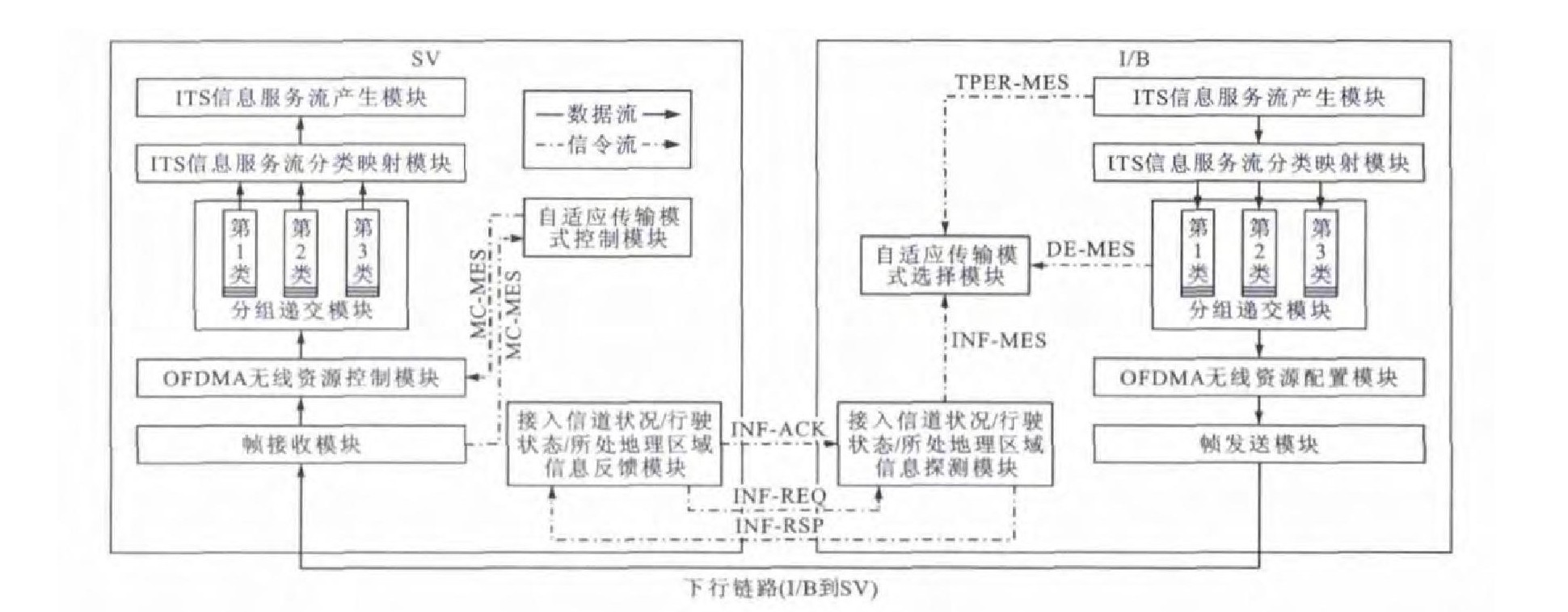Adaptive transmission mode selection strategy of vehicle communication access system
-
摘要: 为提高智能交通系统(ITS) 有效传输各类信息服务流的能力, 将自适应调制编码(AMC) 和正交频分多址接入(OFDMA) 技术引入车辆通信接入子系统, 提出了一种自适应传输模式选择策略。当车辆行驶在非特殊地理区域或行驶速度低于60km·h-1时, 车辆通信接入系统将启动自适应传输模式选择进程。与典型策略采用固定不变的AMC传输模式信噪比切换阈值相比, 建议策略的切换阈值可变, 且由ITS信息服务流目标分组差错率来决定, 从而使系统在传输不同类型的ITS信息服务流时, 有可能在相同的接入信道状况下采用不同的调制编码模式等级, 进而获得更高的数据有效传输速率。通过数学分析对选择策略的各类服务流目标分组差错率和系统平均有效数据传输速率进行性能评估。分析结果表明: 建议策略能够在传输可靠性和高效性之间做出更好的权衡; 当第1、2、3类ITS信息服务流的目标分组差错率分别为10-6、10-5、10-2时, 建议策略能够在满足传输可靠性要求的同时, 将典型策略的系统平均有效数据传输速率提升8%。Abstract: In order to improve the capability of intelligent transportation system (ITS) for effective transmitting of all kinds of information service flows, the technologies of adaptive modulation and coding (AMC) and orthogonal frequency division multiple access (OFDMA) were introduced into the vehicle communication access subsystem, and an adaptive transmission mode selection strategy was proposed. When the vehicle ran in a special geographic region or at a driving speed below 60km·h-1, the process of adaptive transmission mode selection would be triggered by the vehicle communication access system. Compared to the fixed SNR switching thresholds of AMC transmission modes of the typical strategies, the switching thresholds of the proposed strategy were variable and determined by the target packet error rate of ITS information service flow. In this case, different modulation and coding mode levels were probably used for the same access channel condition with different kinds of information service flows transmitting toobtain higher effective data transmission rate. All kinds of service flow target packet error rates and system average effective data transmission rates of the selection strategy were evaluated by using mathematical analysis. Analysis result indicates that the proposed strategy can make better tradeoff between transmission reliability and efficiency. When the target packet error rates of the first, second and third kind of ITS information service flow are 10-6, 10-5 and 10-2 respectively, the proposed strategy is recommended to improve the system average data transmission rate of the typical strategy by 8% with fulfilling the transmission reliability requirements at the same time.
-
表 1 信令信息
Table 1. Signaling informations

表 2 六级调制编码模式
Table 2. Modulation and coding modes with 6levels

表 3 ITS信息服务流实例及相应目标分组差错率
Table 3. ITS information service flow examples and corresponding target packet error rates

表 4 六级调制编码模式分组差错率曲线拟合参数
Table 4. Fitting parameters of packet error rate curves of modulation and coding modes with 6levels

表 5 AMC传输模式SNR切换阈值
Table 5. SNR switching thresholds of AMC transmission modes dB

-
[1] PAPADIMITRATOS P, LAFORTELLE A, EVENSSEN K, et al. Vehicular communication systems: enabling technologies, applications, and future outlook on intelligent transportation[J]. IEEE Communications Magazine, 2009, 47 (11): 84-95. doi: 10.1109/MCOM.2009.5307471 [2] IEEE Std 802.11pTM—2010, IEEE standard for information technology—telecommunications and information exchange between systems—local and metropolitan area networks—specific requirements[S]. [3] IEEE Std 1609.3TM—2007, IEEE trial-use standard for wireless access in vehicular environments (WAVE) —networking services[S]. [4] ASTM E2213-03—2010, standard specification for telecommunications and information exchange between roadside and vehicle systems—5GHz band dedicated short range communications (DSRC) medium access control (MAC) and physical layer (PHY) specifications[S]. [5] UZCATEGUI R, ACOSTA-MARUM G. WAVE: a tutorial[J]. IEEE Communications Magazine, 2009, 47 (5): 126-133. doi: 10.1109/MCOM.2009.4939288 [6] JIANG D, TALIWAL V, MEIER A, et al. Design of 5.9GHz DSRC-based vehicular safety communication[J]. Wireless Communications, 2006, 13 (5): 36-43. doi: 10.1109/WC-M.2006.250356 [7] CHOU C M, LI Chen-yuan, CHIEN W M, et al. A feasibility study on vehicle-to-infrastructure communication: WiFi vs. WiMAX[C]∥IEEE. 2009IEEE International Conference on Mobile Data Management: Systems, Services and Middleware. Taipei: IEEE, 2009: 397-399. [8] REMY G, SENOUCI S M, JAN F, et al. LTE4V2X: LTE for a centralized VANET organization[C]∥IEEE. 2011IEEE Global Telecommunications Conference. Houston: IEEE, 2011: 1-6. [9] ABID H, CHUNG T C, LEE S Y, et al. Performance analysis of LTE smartphones-based vehicle-to-infrastructure communication[C]∥IEEE. Proceedings of the 2012 9th International Conference on Ubiquitous Intelligence and Computing and 9th International Conference on Autonomic and Trusted Computing. Fukuoka: IEEE, 2012: 72-78. [10] VINEL A. 3GPP LTE versus IEEE 802.11p/WAVE: which technology is able to support cooperative vehicular safety applications?[J]. Wireless Communications Letters, 2012, 1 (2): 125-128. doi: 10.1109/WCL.2012.022012.120073 [11] MOSYAGIN J. Using 4G wireless technology in the car[C]∥IEEE. 2010 12th International Conference on Transparent Optical Networks. Munich: IEEE, 2010: 1-4. [12] GOLDSMITH A J, CHUA S G. Adaptive coded modulation for fading channels[J]. IEEE Transactions on Communications, 1998, 46 (5): 595-602. doi: 10.1109/26.668727 [13] ALOUINI M S, GOLDSMITH A J. Adaptive modulation over Nakagami fading channels[J]. Wireless Personal Communications, 2000, 13 (1/2): 119-143. doi: 10.1023/A:1008979107539 [14] MARCELINO H, ZENG Hua-shen, GUAN Yan-bin. Performance analysis of OFDMA system in next generation wireless communication networks[C]∥IEEE. 2010 3rd IEEE International Conference on Computer Science and Information Technology. Chengdu: IEEE, 2010: 335-339. [15] TARHINI C, CHAHED T. AMC-aware QoS proposal for OFDMA-based IEEE 802.16 WiMAX systems[C]∥IEEE. 2007IEEE Global Telecommunications Conference. Washington DC: IEEE, 2007: 4780-4784. [16] LIU Qing-wen, WANG Xin, GIANNAKIS G B. A crosslayer scheduling algorithm with QoS support in wireless networks[J]. IEEE Transactions on Vehicular Technology, 2006, 55 (3): 839-847. doi: 10.1109/TVT.2006.873832 [17] LIU Qing-wen, WANG Xin, GIANNAKIS G B. Cross-layer combining of adaptive modulation and coding with truncated ARQ over wireless links[J]. IEEE Transactions on Wireless Communications, 2004, 3 (5): 1746-1755. doi: 10.1109/TWC.2004.833474 [18] 陈婷, 李建东, 李长乐. WiMAX中基于跨层设计的SNR阈值区间可变式自适应调制编码机制[J]. 中国通信, 2010, 7 (2): 153-159. https://www.cnki.com.cn/Article/CJFDTOTAL-ZGTO201002020.htmCHEN Ting, LI Jian-dong, LI Chang-le. A novel AMC scheme with alterable SNR threshold intervals based on crosslayer design in WiMAX[J]. China Communications, 2010, 7 (2): 153-159. (in Chinese). https://www.cnki.com.cn/Article/CJFDTOTAL-ZGTO201002020.htm -





 下载:
下载:







